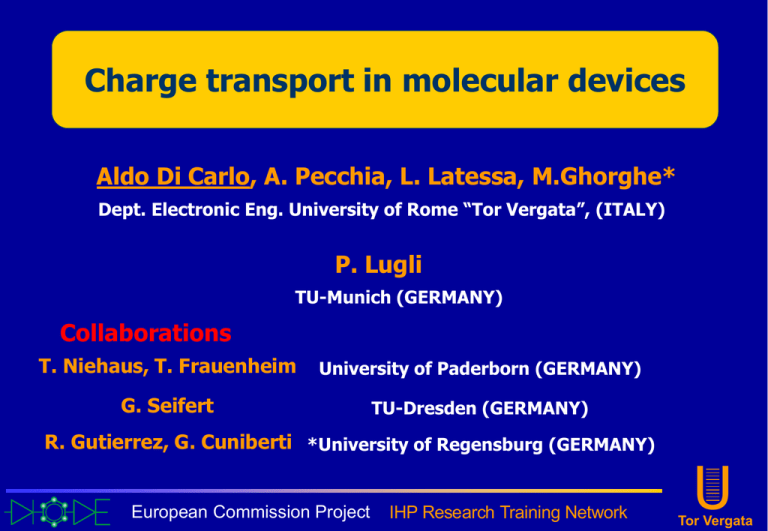Tor Vergata
advertisement

Charge transport in molecular devices
Aldo Di Carlo, A. Pecchia, L. Latessa, M.Ghorghe*
Dept. Electronic Eng. University of Rome “Tor Vergata”, (ITALY)
P. Lugli
TU-Munich (GERMANY)
Collaborations
T. Niehaus, T. Frauenheim
University of Paderborn (GERMANY)
G. Seifert
TU-Dresden (GERMANY)
R. Gutierrez, G. Cuniberti *University of Regensburg (GERMANY)
European Commission Project
IHP Research Training Network
U
Tor Vergata
What about realistic nanostructured devices ?
Inorganics
1D (quantum wells): 100-1000 atoms in the unit cell
2D (quantum wires): 1000-10’000 atoms in the unit cell
3D (quantum dots): 100’000-1’000’000 atoms in the unit cell
Organics
Molecules, Nanotubes, DNA: 100-1000 atoms (or more)
Traditionally, nanostructures are studied via k · p approaches in the context of the
envelope function approximation (EFA). In this case, only the envelope of the
nanostructure wavefunction is considered, regardless of atomic details.
Modern technology, however, pushes nanostructures to dimensions, geometries
and systems where the EFA does not hold any more.
Atomistic approaches are required for the modeling structural, electronic and
optical properties of modern nanostructured devices.
U
Tor Vergata
Transport in nanostructures
active region where symmetry is lost
The transport problem is:
+
contact regions (semi-infinite bulk)
contact
contact
contact
active
region
Open-boundary conditions can be treated within several schemes:
• Transfer matrix
• LS scattering theory
• Green Functions ….
These schemes are well suited for localized orbital approach like TB
U
Tor Vergata
Atomistic approaches:
The Tight-Binding method
We attempt to solve the one electron Hamiltonian in
terms of a Linear Combination of Atomic Orbitals (LCAO)
n r
a C a a r R
atomic
site, i
i
i
orbitals,
b H a
i , jb
atomic
site,j
i
orbital
Cia
ESia , jb C jb 0
orbitals,
H ia , jb ia H jb
Sia , jb ia jb
The approach can be implemented “ab-initio” where the orbitals are the basis
functions and Hia ,jb is evaluated numerically
U
Tor Vergata
Scalability of TB approaches
Empirical Tight-Binding
Hamiltonian matrix elements are obtained by comparison of calculated quantities
with experiments or ab-initio results. Very efficient, poor transferability.
Semi-Empirical Tight-Binding
Density Functional Tight-Binding
Density-functional based methods permit an accurate and theoretically well
founded description of electronic properties for a wide range of materials.
U
Tor Vergata
Si/SiO2 tunneling:. empirical TB sp3d5s*
Staedele, et al.
J. Appl. Phys. 89 348 (2001 )
Sacconi et al.
Solid State Elect. 48 575 (‘04)
IEEE TED in press
SiO2
b-critobalite
Poly-Si-gate
p-Si
b-quartz
tridymite
Empirical parameterizations are necessary due to the band gap problem of
ab-initio approaches
U
Tor Vergata
Exp. [Khairurrjial et al. JAP 87, 3000 (2000)]
tox=2.8 nm
0.1
2
Current Density [A/cm ]
Tunneling Current:
Comparison with experimental data
0.01
E E
mE mCB 1 CB
E
g
non-par. EMA
1E-3
1E-4
b-cristobalite
tridimite
1E-5
b-quartz
1E-6
1E-7
par. EMA
1E-8
0.0
0.5
1.0
1.5
2.0
2.5
Oxide voltage [V]
Good agreement between experimental and TB results for the b-cristobalite polimorph
Slope of the current density is related to the microscopic structure of SiO2
U
Tor Vergata
Toward ”ab-initio” approaches.
Density Functional Tight-Binding
Many DFT tight-binding: SIESTA (Soler etc.), FIREBALL (Sankey),
DMOL (Delley), DFTB (Seifert, Frauenheim etc.) …..
The DFTB approach [Elstner, et al. Phys. Rev. B 58 (1998) 7260]
provides transferable and accurate interaction potentials. The numerical
efficiency of the method allows for molecular dynamics simulations in large
super cells, containing several thousand of atoms.
• DFTB is fully scalable (from empirical to DFT)
• DFTB allows also for TD-DFT simulations
We have extended the DFTB to account for transport in organic/inorganic
nanostructures by using Non Equilibrium Green Function approach selfconsistently coupled with Poisson equation
U
Tor Vergata
DFTB
Tight-binding expansion of the wave functions
[Porezag, et al Phys. Rev. B 51 (1995) 12947]
DFT calculation of the matrix elements, two-centers approx.
II order-expansion of Kohn-Sham energy functional
[Elstner, et al. Phys. Rev. B 58 (1998) 7260]
E
(2)
1
ni i H 0 i q q E rep
2 ,
i
Self-Consistency in the charge density (SCC-DFTB)
U
Tor Vergata
Non equilibrium systems
The contact leads are two reservoirs in equilibrium at two
different elettro-chemical potentials.
f2
f1
How do we fill up the states ?
How to compute current ?
U
Tor Vergata
How do we fill up states ? (Density matrix)
The crucial point is to calculate the non-equilibrium density matrix when an
external bias is applied to the molecular device
Three possible solutions:
1. Ignore the variation of the density matrix (we keep H0)
Suitable for situations very close to equilibrium
(Most of the people do this !!!!)
2. The new-density matrix is calculated in the usual way
by diagonalizing the Hamiltonian for the finite system
Problem with boundary conditions, larger systems
3. The new-density is obtained from the Non-Equilibrium
Green’s Function theory
[Keldysh ‘60] [Caroli et al. ’70] [Datta ’90]
...
U
...
Tor Vergata
DFTB
+
Green Functions
Systems close to the equilibrium
• Molecular vibrations and current
(details: Poster 16)
U
Tor Vergata
The role of molecular vibrations
T= 300 K
An organic molecule is a rather floppy entity
We compare:
• Time-average of the current computed at every step of a
MD simulation (Classical vibrations)
•
Ensemble average of over the lattice fluctuations
(quantum vibrations = phonons).
A. Pecchia et al. Phys. Rev. B. 68, 235321 (2003).
U
Tor Vergata
Molecular Dynamics + current
Di Carlo, Physica B, 314, 211 (2002)
The dynamics of the a-th atom is given by
d 2 Ra
Ma
Fa= nk
2
k
dt
k
dErep
dH
k
dRa
dRa
The evolution of the system is performed on a time scale of ~ 0.01 fs
Molecular dynamics
Molecular dynamics + current
Hamiltonian matrix
Hamiltonian matrix
Calculation of the forces
t=t+t
Current calculation [ J(t) ]
t=t+t
Atomic position update
Calculation of the forces
Atomic position update
U
Tor Vergata
Molecular dynamics limitations
The effect of vibrations on the current flowing in the molecuar device,
via molecular dynamics calculations, has been obtained without
considering the quantization effects of the vibrational field.
The quantum nature of the vibrations (phonons) is not considered !
However, vibration quantization can be considered by performing ensamble
averages of the current over phonon displacements
H. Ness et al, PRB 63, 125422
How does it compare with MD calculations ?
U
Tor Vergata
The lowest modes of vibration
U
Tor Vergata
Phonons
H. Ness et al, PRB 63, 125422
The hamiltonian is a superposition of the vibrational eigenmodes, k:
1 3N 1 2
2 2
H
mk k qk
2
2 k 1 mk qk
The eigenmodes are one-dimesional harmonic oscillators with a
gaussian distribution probability for qk coordinates:
2
2 2
m
m
BE
k
k qk
Pk qk , K BT
exp(
)
2 Eth ( k , K BT )
2 Eth ( k , K BT )
1
Eth nth , kT
2
U
Tor Vergata
The current calculation
•
The tunneling probability is computed as an ensemble
average over the atomic positions (DFTB code + Green Fn.)
T tr LGDr R GDa
•
We average the log(T) because T is a statistically ill-defined
quantity (is dominated by few events). MC integration
log T ( E ) dq1 ...dq3 N log T ({q1...q3 N })
k
•
1
2 k
e
qk2
2 k2
The current is computed as usual:
2e
i ( E ) exp( log T ( E ) )[ f1 ( E ) f 2 ( E )]dE
h
U
Tor Vergata
Transmission functions
MD Simulations
Quantum average
U
Tor Vergata
Comparison: MD, Quantum PH, Classical PH
Current [A]
1E-7
MD
QPH
CPH
1E-8
0
100
200
300
400
500
Temperature [K]
QPH = phonon treatement
CPH = phonons treatement without zero point energy
U
Tor Vergata
Frequency analysis of MD results
Mol. Dynamics
Ph-twist
S-Au stretch
CC stretch
Fourier Transf.
A. Pecchia et al. Phys. Rev. B. 68, 235321 (2003).
U
Tor Vergata
I-V characteristics
Molecular dynamics
Quantum phonons
Harmonic approximation failure produces incorrect results of the quantum phonon
treatement of current flowing in the molecule
U
Tor Vergata
DFTB
+
Non-Equilibrium Green Functions
• Full Self-Consistent results
• Electron-Phonon scattering
(details: Posters 34 and 37)
U
Tor Vergata
Self-consistent quantum transport
Self-consistent loop:
BULK
Device
Surface
SELF-CONS. DFTB
WITH POISSON
3D MULTI-GRID
Surface
BULK
Di Carlo et. al. Physica B, 314, 86 (2002)
1
dE
G
2 i
Density Matrix
q q0 S Mullikan charges
Correction
n 2V H 4 n
SC-loop
H G n '
h
I
Tr [ (E )G (E ) (E )G (E )]dE
2e
U
Tor Vergata
Charge and Potential in two CNT tips
Potential Profile
Equilibrium charge density
Charge density with 1V bias
Charge neutrality of the system
is only achived in large systems
Net charge density
Negative charge
Positive charge
U
Tor Vergata
Self-consistent charge in a molecular wire
0.5 V
1.0 V
U
Tor Vergata
CNT-MOS: Coaxially gated CNT
y
z
VG
x
VD
CNT contact
5 nm
1.5 nm
VS=0
Semiconducting
(10,0) CNT
Insulator (εr=3.9)
U
Tor Vergata
CNT-MOS
2.10-5
0
-4.10-5
-8.10-5
Potential
Charge
Isosurfaces of Hartree potential and contour plot of
charge density transfer computed for an applied gate bias
of 0.2 V and a source-drain bias 0f 0.0 V
U
Tor Vergata
Output characteristics
Gate coupling (capacitance) is too low. A precise design
is necessary (well tempered CNT-MOS)
U
Tor Vergata
Electron-phonon self-energy
The el-ph interaction is included to first order (Born approximation)
in the self-energy expansion. [A. Pecchia, A. Di Carlo Report Prog. in Physics (2004)]
Born –approximation
Directly from DFTB hamiltonian
i
(E )
2
2
dE
'
G
(
E
E
')
D
q
0
q (E ')
q
G (E ) G r (E ) (E )G a (E )
h
I
Tr [ (E )G (E ) (E )G (E )]dE
2e
U
Tor Vergata
Simple linear chain system
resonance
absorption
emission
q=17 meV, E0 = 0.06 eV
incoherent
coherent
U
Tor Vergata
I(E)
Inelastic scattering: Current + phonons
U
Tor Vergata
Current (A)
IV Current + phonons
24
22
20
18
16
14
12
10
8
6
4
2
0
T=0 K
T=150 K
No phonons
Coherent
Incoherent
0.0
0.5
1.0
1.5
2.0
2.5
3.0
3.5
4.0
Applied Voltage [V]
U
Tor Vergata
Conclusions
The method
Density Functional Tight-Binding approach has been extended to
account for current transport in molecular devices
by using Self-consistent non-equilibrium Green function (gDFTB ).
DFTB is a good compromise between simplicity and reliability.
The use of a Multigrid Poisson solver allows for study very
complicated device geometries
Force field and molecular dynamics can be easily accounted in the
current calculations.
Electron-phonon coupling can be directly calculated via DFTB
Electron-phonon interaction has been included in the current
calculations.
For the gDFTB code visit: http://icode.eln.uniroma2.it
U
Tor Vergata
Conclusions
Results
Anharmonicity of molecular vibrations can limit the use of phonon
concepts
Concerning ballistic transport, temperature dependence of current is
better described whit molecular dynamics than ensamble averages of
phonon displacements
Screening length in CNT could be long.
Coaxially gated CNT presents saturation effects but gate control is
critical.
Electron-phonon scattering is not negligible close to resonance
conditions of molecular devices
All the details in A. Pecchia, A. Di Carlo Report Prog. in Physics (2004)
For the gDFTB code visit: http://icode.eln.uniroma2.it
U
Tor Vergata







